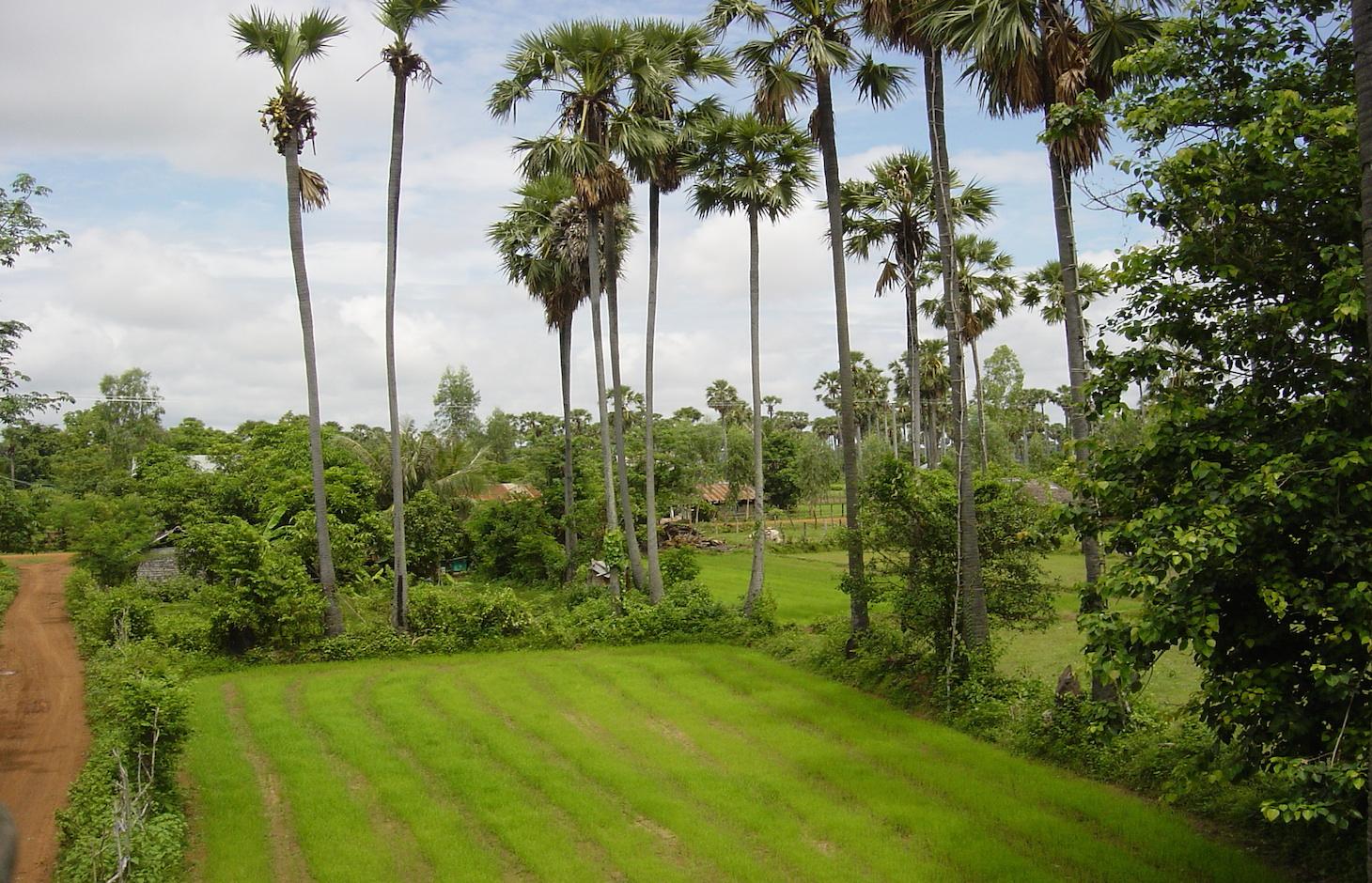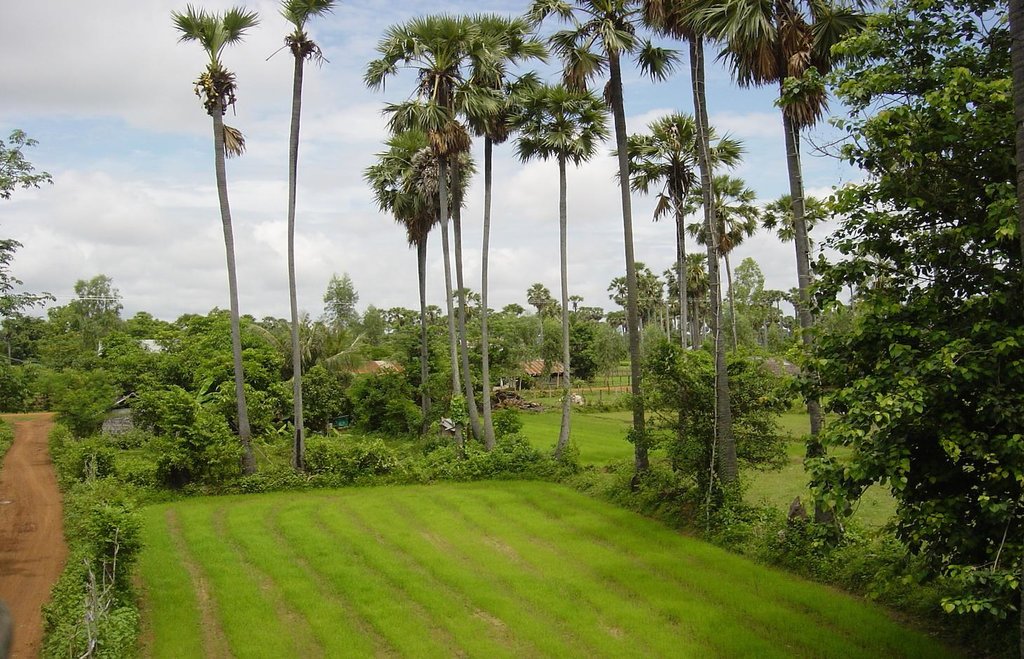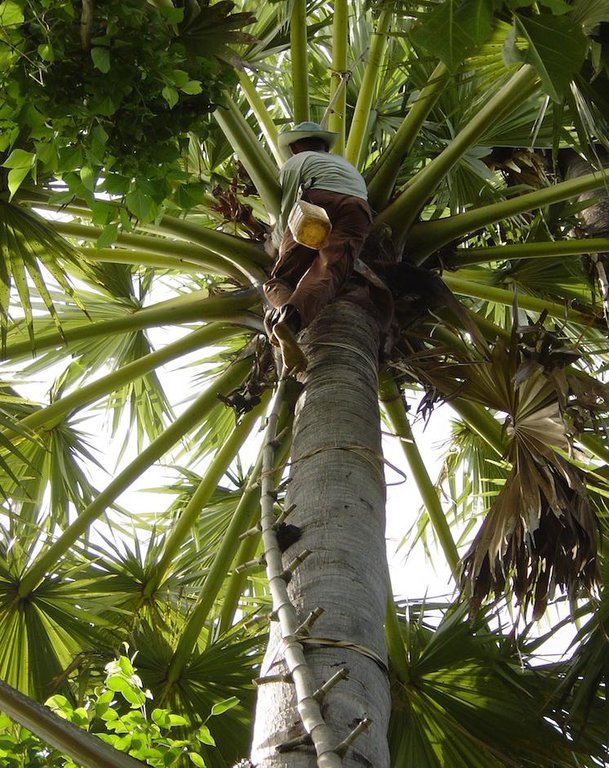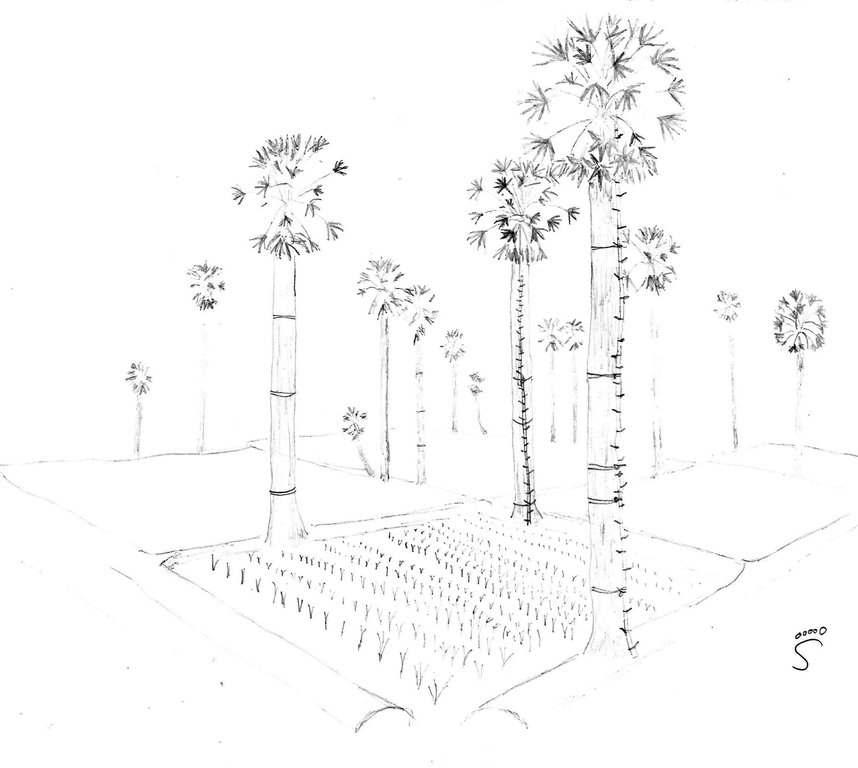Multipurpose use of sugar palm grown on rice field dykes. [Camboja]
- Criação:
- Atualização:
- Compilador/a: Stefan Graf
- Editor: –
- Revisores: Deborah Niggli, Alexandra Gavilano
ការប្រើប្រាស់ដើមតោ្នតដែលដំានៅតាមភ្លឺស្រែ (Khmer)
technologies_1629 - Camboja
Veja as seções
Expandir tudo Recolher tudo1. Informação geral
1.2 Detalhes do contato das pessoas capacitadas e instituições envolvidas na avaliação e documentação da tecnologia
Especialista em GST:
Khun Lean Hak
SOFDEC/LAREC, www.sofdec.com
1.3 Condições em relação ao uso da informação documentada através de WOCAT
O/a compilador/a e a(s) pessoa(s) capacitada(s) aceitam as condições relativas ao uso de dados documentados através da WOCAT:
Sim
1.4 Declaração de sustentabilidade da tecnologia descrita
A tecnologia descrita aqui é problemática em relação a degradação da terra de forma que não pode ser declarada uma tecnologia de gestão sustentável de terra?
Não
2. Descrição da tecnologia de GST
2.1 Descrição curta da tecnologia
Definição da tecnologia:
Sugar palms growing on the dykes along the rice fields are used as source of income and have different effects on the growing of the rice, like reducing the wind speed and thus the evaporation and wind erosion.
2.2 Descrição detalhada da tecnologia
Descrição:
The sugar palm (Borassus flabellifer ) is the national tree of Cambodia, it is well adapted to the local natural environment and there is a long tradition to grow sugar palms. Therefore, only a negligible workload is required for both the establishment (fruits falling down from the already existing trees will grow) and the maintenance of the trees. As the sugar palm is resistant to waterlogging and floods (even in flooded areas in the floodplains), and it grows well at low pH, it is planted/grown on the rice field dykes and around the houses. The trees which are growing around the paddy fields have some positive effects on both soil and rice, as they slow down the wind and thus reduce evaporation and wind erosion. They also attract wildlife, and thus allow the establishment of other vegetation. The trees also have a purifying effect on the groundwater, and cycle the nutrients which are otherwise lost in the groundwater. The sugar palms and their products can be used in manifold ways: the leaves for wickerwork and roofs; the stems as fences, for ropes and strings; the fruits as food, fodder and to make straw palatable for cattle; the sap as fodder, to make wine, sugar, and vinegar; and the trunk as construction wood – these are only some of its uses. They reduce the risk of a complete crop failure, as their products are not subject to weather fluctuations.
After the collectivization of land during the civil war (1975-1979), the land and the trees were newly distributed to the people according to the size of the household. The ownership of the land and of the trees was not related. Until today, the trees can be growing on someone’s land, but can be sold or rented to somebody else who harvests its products.
The main reason to plant sugar palms in this area is the sap collection. In order to collect the sap, firstly bamboo ladders are tied to the sugar palm trees. In the dry season, the tapper climbs up the trees to collect the sap. The male or female inflorescence is crushed with a special tool and a piece of it sliced off. Bottles are hanged beneath the cut part, and the sap will flow into these bottles. The crushing and slicing is repeated twice a day, so the amount of collected sap can be optimized. Most of the sap is cooked on a fire and made into syrup, and if there is too much sap, it is fermented and sold as palm wine.
The fruits that fall down on the rice fields are thrown on the dykes, where they grow. The seedlings tolerate some cattle grazing, as long as only the leaves and not the bud are eaten.
The analysed area is flat (slope < 2%), with a tropical climate (dry season from November to May and wet season from June to October), and the soils are mostly sandy or loamy. The soil has a low fertility, contains little organic matter, and acidifies. The area has been deforested a long time ago, and the groundwater table is rather high (1-2 m during the dry season, on the surface during wet season). Due to climate change, farmers notice more erratic rainfalls, temperature rises and more recurrent droughts. Rice is the predominant crop grown in the area, since it serves as staple food (mix subsistence and commercial activities).
The increasing migration rate (the young generation leaves the villages to work in the cities, garment industry or abroad) results in a decrease of available labour force in the area which has detrimental effects on the agricultural activities. Furthermore, the civil war in the 1970s (Khmer Rouge) led to the loss of agricultural knowledge which different NGOs try to re-establish.
2.3 Fotos da tecnologia
2.5 País/região/locais onde a tecnologia foi aplicada e que estão cobertos nesta avaliação
País:
Camboja
Região/Estado/Província:
Kampong Chhnang
Especificação adicional de localização:
Rolear Bier / Thnorng Kombot
Especifique a difusão da tecnologia:
- Uniformemente difundida numa área
Se a área precisa não for conhecida, indicar a área aproximada coberta:
- 10-100 km2
Comentários:
This technology is applied in most parts of Cambodia. Almost everywhere there are some sugar palms growing along the rice fields, but not in this density. The area mentioned is the area in the district where the technology is applied.
2.6 Data da implementação
Caso o ano exato seja desconhecido, indique a data aproximada:
- mais de 50 anos atrás (tradicional)
2.7 Introdução da tecnologia
Especifique como a tecnologia foi introduzida:
- Como parte do sistema tradicional (>50 anos)
Comentários (tipos de projeto, etc.):
It is a traditional tree in Cambodia, with historical use. Its introduction on the rice field dykes is unknown.
3. Classificação da tecnologia de GST
3.1 Principal/principais finalidade(s) da tecnologia
- Melhora a produção
- Reduz, previne, recupera a degradação do solo
3.2 Tipo(s) atualizado(s) de uso da terra onde a tecnologia foi aplicada
Uso do solo misturado dentro da mesma unidade de terra:
Sim
Especificar o uso misto da terra (culturas/ pastoreio/ árvores):
- Agrofloresta

Terra de cultivo
- Cultura anual
- Cultura de árvores e arbustos
- rice
- sugar palm
Número de estações de cultivo por ano:
- 1
Especifique:
Longest growing period in days: 210, Longest growing period from month to month: June-December
Comentários:
Major land use problems (compiler’s opinion): Lack of organic matter, lack of water retention in soil, irregularity of rainfall, low soil fertility (sandy soil), monocultures, bare soil during dry season, ploughing, wind erosion and dust storms.
Major land use problems (land users’ perception): Soil fertility is low, rainfall is not secured in the beginning of the rainy season.
3.4 Abastecimento de água
Abastecimento de água para a terra na qual a tecnologia é aplicada:
- Precipitação natural
3.5 Grupo de GST ao qual pertence a tecnologia
- Agrofloresta
- Quebra-vento/cerca de árvores
3.6 Medidas de GST contendo a tecnologia

Medidas vegetativas
- V1: cobertura de árvores/arbustos
Comentários:
Type of vegetative measures: aligned: -along boundary
3.7 Principais tipos de degradação da terra abordados pela tecnologia

Erosão do solo pelo vento
- Et: Perda do solo superficial

Deteriorização química do solo
- Cn: declínio de fertilidade e teor reduzido de matéria orgânica (não causado pela erosão)

Degradação biológica
- Bh: perda dos habitats
- Bs: Qualidade e composição de espécies/declínio de diversidade
Comentários:
Main causes of degradation: soil management (Ploughing of the soil. Depending on the rainfall, sometimes the land is left bare for several days or weeks.), crop management (annual, perennial, tree/shrub) (Mainly rice is grown in monocultures.), over-exploitation of vegetation for domestic use (Straw is usually removed from the fields.), labour availability (Labour availability is low due to high migration rates (garment industry, drift to the cities, working abroad).)
Secondary causes of degradation: change in temperature (More hot days, the soil dries out faster.), droughts, education, access to knowledge and support services (Little knowledge about soil conservation.), war and conflicts (During the Khmer Rouge regime, a lot of agricultural knowledge got lost.)
3.8 Redução, prevenção ou recuperação da degradação do solo
Especifique o objetivo da tecnologia em relação a degradação da terra:
- Prevenir degradação do solo
4. Especificações técnicas, implementação de atividades, entradas e custos
4.1 Desenho técnico da tecnologia
Especificações técnicas (relacionada ao desenho técnico):
Sugar palms (Borassus flabellifer) with bamboo ladders growing on the dikes around the rice fields.
Kampong Chhnang
Date: 2014
Technical knowledge required for field staff / advisors: low
Technical knowledge required for land users: low (They grow almost by themselves, as the fallen fruits are just thrown on the dykes as only management.)
Main technical functions: reduction in wind speed
Secondary technical functions: increase in nutrient availability (supply, recycling,…), increase / maintain water stored in soil
Aligned: -along boundary
Vegetative material: F : fruit trees / shrubs
Number of plants per (ha): 63
Vertical interval between rows / strips / blocks (m): 20
Vertical interval within rows / strips / blocks (m): 10
Fruit trees / shrubs species: Mostly naturally regenerated, but seeds are thrown on the dykes when they fall into the rice fields.
Autor:
Stefan Graf, Switzerland
4.2 Informação geral em relação ao cálculo de entradas e custos
Indique a média salarial da mão-de-obra contratada por dia:
5.00
4.3 Atividades de implantação
| Atividade | Periodicidade (estação do ano) | |
|---|---|---|
| 1. | Build a stove and buy pans to cook the sap into sugar. |
4.4 Custos e entradas necessárias para a implantação
| Especifique a entrada | Unidade | Quantidade | Custos por unidade | Custos totais por entrada | % dos custos arcados pelos usuários da terra | |
|---|---|---|---|---|---|---|
| Mão-de-obra | Labour | ha | 1,0 | 10,0 | 10,0 | 100,0 |
| Equipamento | machine use | ha | 1,0 | 25,0 | 25,0 | 100,0 |
| Custos totais para a implantação da tecnologia | 35,0 | |||||
| Custos totais para o estabelecimento da Tecnologia em USD | 35,0 | |||||
4.5 Atividades recorrentes/manutenção
| Atividade | Periodicidade/frequência | |
|---|---|---|
| 1. | Tie the bamboo ladders to the tree | |
| 2. | Collect the sap by pressing the inflorescence, cutting a slice off and putting a bottle underneath. | December-April, twice a day |
| 3. | Cook the sap to make sugar | Once or twice a day |
| 4. | Ferment the juice to make palm wine | If there's too much juice. |
4.6 Custos e entradas necessárias pata a manutenção/atividades recorrentes (por ano)
| Especifique a entrada | Unidade | Quantidade | Custos por unidade | Custos totais por entrada | % dos custos arcados pelos usuários da terra | |
|---|---|---|---|---|---|---|
| Mão-de-obra | Labour | ha | 1,0 | 3221,0 | 3221,0 | 100,0 |
| Material de construção | Firewood | ha | 1,0 | 357,0 | 357,0 | 100,0 |
| Material de construção | Bamboo and rattan | ha | 1,0 | 471,0 | 471,0 | 100,0 |
| Custos totais para a manutenção da tecnologia | 4049,0 | |||||
| Custos totais de manutenção da Tecnologia em USD | 4049,0 | |||||
Comentários:
Machinery/ tools: Self-made crusher to induce a higher sap flow.
The costs were calculated with 44 trees (one unit), transformed into 62 trees per ha. The assessed farmer owns 0.35 ha of rice fields, with 22 trees on the dykes, but he bought additional trees on nearby dykes. The whole family is involved in the process.
The maintenance costs indicated above are that high because labour was calculated for each step. However, a big part of the work is done voluntarly by local land users and are not payed.
4.7 Fatores mais importantes que afetam os custos
Descreva os fatores mais determinantes que afetam os custos:
The factors affecting the costs are mainly the inputs (firewood, work to cook the sap to sugar) used to transform the sap into saleable products. They are not necessary to benefit from the positive effects of sugar palms on the microclimate and soil. To implement sugar palms on the rice field dikes the costs are negligible.
5. Ambiente natural e humano
5.1 Clima
Precipitação pluviométrica anual
- <250 mm
- 251-500 mm
- 501-750 mm
- 751-1.000 mm
- 1.001-1.500 mm
- 1.501-2.000 mm
- 2.001-3.000 mm
- 3.001-4.000 mm
- > 4.000 mm
Especificações/comentários sobre a pluviosidade:
1486.45 mm 2013 in Kampong Chhnang
Zona agroclimática
- Subúmido
Thermal climate class: tropics. 27-35°C
5.2 Topografia
Declividade média:
- Plano (0-2%)
- Suave ondulado (3-5%)
- Ondulado (6-10%)
- Moderadamente ondulado (11-15%)
- Forte ondulado (16-30%)
- Montanhoso (31-60%)
- Escarpado (>60%)
Formas de relevo:
- Planalto/planície
- Cumes
- Encosta de serra
- Encosta de morro
- Sopés
- Fundos de vale
Zona de altitude:
- 0-100 m s.n.m.
- 101-500 m s.n.m.
- 501-1.000 m s.n.m.
- 1.001-1.500 m s.n.m.
- 1.501-2.000 m s.n.m.
- 2.001-2.500 m s.n.m.
- 2.501-3.000 m s.n.m.
- 3.001-4.000 m s.n.m.
- > 4.000 m s.n.m.
5.3 Solos
Profundidade do solo em média:
- Muito raso (0-20 cm)
- Raso (21-50 cm)
- Moderadamente profundo (51-80 cm)
- Profundo (81-120 cm)
- Muito profundo (>120 cm)
Textura do solo (solo superficial):
- Grosso/fino (arenoso)
- Médio (limoso, siltoso)
Matéria orgânica do solo superficial:
- Médio (1-3%)
- Baixo (<1%)
5.4 Disponibilidade e qualidade de água
Lençol freático:
< 5 m
Disponibilidade de água de superfície:
Precário/nenhum
Qualidade da água (não tratada):
Água potável precária (tratamento necessário)
Comentários e outras especificações sobre a qualidade e a quantidade da água:
Ground water table: during dry season
Availability of surface water: during dry season
Drinking water: People use it for drinking after filtering or boiling.
5.5 Biodiversidade
Diversidade de espécies:
- Médio
5.6 Características dos usuários da terra que utilizam a tecnologia
Orientação de mercado do sistema de produção:
- misto (subsistência/comercial)
Rendimento não agrícola:
- 10-50% de toda renda
Nível relativo de riqueza:
- Pobre
- Média
Indivíduos ou grupos:
- Indivíduo/unidade familiar
Nível de mecanização:
- Trabalho manual
Gênero:
- Mulheres
- Homens
Indique outras características relevantes dos usuários da terra:
Land users applying the Technology are mainly common / average land users
Population density: 50-100 persons/km2
Annual population growth: 0.5% - 1%
Off-farm income specification: Handicraft, remittances, and factory work.
5.7 Área média de terrenos utilizados pelos usuários de terrenos que aplicam a Tecnologia
- < 0,5 ha
- 0,5-1 ha
- 1-2 ha
- 2-5 ha
- 5-15 ha
- 15-50 ha
- 50-100 ha
- 100-500 ha
- 500-1.000 ha
- 1.000-10.000 ha
- > 10.000 ha
É considerado pequena, média ou grande escala (referente ao contexto local)?
- Pequena escala
5.8 Propriedade de terra, direitos de uso da terra e de uso da água
Propriedade da terra:
- Comunitário/rural
- Indivíduo, não intitulado
Direitos do uso da terra:
- Comunitário (organizado)
- Indivíduo
Direitos do uso da água:
- Acesso livre (não organizado)
Comentários:
Land users have a title that is not recognized by the state. The trees sold by farmers to neighbours have a paper signed by the village chief to certify the ownership.
5.9 Acesso a serviços e infraestrutura
Saúde:
- Pobre
- Moderado
- Bom
Educação:
- Pobre
- Moderado
- Bom
Assistência técnica:
- Pobre
- Moderado
- Bom
Emprego (p. ex. não agrícola):
- Pobre
- Moderado
- Bom
Mercados:
- Pobre
- Moderado
- Bom
Energia:
- Pobre
- Moderado
- Bom
Vias e transporte:
- Pobre
- Moderado
- Bom
Água potável e saneamento:
- Pobre
- Moderado
- Bom
Serviços financeiros:
- Pobre
- Moderado
- Bom
6. Impactos e declarações finais
6.1 Impactos no local mostrados pela tecnologia
Impactos socioeconômicos
Produção
Produção agrícola
Comentários/especificar:
Leaves fall on the fields, but if they are removed the adverse effect is negligible.
Produção de madeira
Comentários/especificar:
Old trees are logged and used as firewood or construction material.
Risco de falha de produção
Comentários/especificar:
Sugar palms can grow in adverse conditions.
Gestão de terra
Comentários/especificar:
Trees on the dykes might hinder the use of machines on the fields.
Disponibilidade e qualidade de água
Disponibilidade de água potável
Comentários/especificar:
Trees have a purifying effect on the water.
Renda e custos
Rendimento agrícola
Comentários/especificar:
The products of the sugar palms are sold on the market, whereas rice is only grown for sustenance.
Diversidade de fontes de rendimento
Comentários/especificar:
The products of the sugar palms are sold on the market, whereas rice is only grown for sustenance.
Carga de trabalho
Comentários/especificar:
Harvesting and processing of sap is strenuous and time consuming, especially during dry season.
Impactos socioculturais
Estado de saúde
Comentários/especificar:
Cheap alcohol, diabetes
Oportunidades culturais
Comentários/especificar:
Aesthetic value.
contribution to human well-being
Comentários/especificar:
The products of the sugar palms generate income to the land user and his family (rice is only used for home consumption), and they are more resilient to erratic rainfall patterns.
Impactos ecológicos
Ciclo hídrico/escoamento
Lençol freático/aquífero
Comentários/especificar:
The roots reach the ground water table, and have a difficult to quantify effect on it.
Evaporação
Comentários/especificar:
Evaporation is tackled due to the decrease of wind speed.
Solo
Umidade do solo
Comentários/especificar:
Evaporation is tackled due to the decrease of wind speed.
Ciclo e recarga de nutrientes
Comentários/especificar:
Nutrients below the root level of annuals are picked up and reintroduced in the nutrient cycle.
Biodiversidade: vegetação, animais
Biomassa/carbono acima do solo
Diversidade vegetal
Comentários/especificar:
The region is prone to monocultures (rice), however in this region there are a lot of sugar palms and other tree species. Sugar palms protect the other plants, attract birds (dissemination of seeds) and have therefore a positive impact on biodiversity.
Diversidade animal
Comentários/especificar:
Sugar palms as habitat for different animals (bats, birds, etc.)
Espécies benéficas
Diversidade de habitat
Clima e redução de riscos de desastre
Velocidade do vento
6.2 Impactos externos mostrados pela tecnologia
Poluição de água subterrânea/rio
Comentários/especificar:
Purifying effects of trees.
Sedimentos transportados pelo vento
Comentários/especificar:
Reduction of wind velocity.
Deforestation
Comentários/especificar:
Firewood is used as the main source of energy. The land user buys the wood.
6.3 Exposição e sensibilidade da tecnologia às mudanças climáticas graduais e extremos/desastres relacionados ao clima (conforme o ponto de vista dos usuários da terra)
Mudança climática gradual
Mudança climática gradual
| Estação do ano | aumento ou diminuição | Como a tecnologia lida com isso? | |
|---|---|---|---|
| Temperatura anual | aumento | bem |
Extremos (desastres) relacionados ao clima
Desastres meteorológicos
| Como a tecnologia lida com isso? | |
|---|---|
| Temporal local | bem |
| Tempestade de vento local | bem |
Desastres climatológicos
| Como a tecnologia lida com isso? | |
|---|---|
| Seca | bem |
Desastres hidrológicos
| Como a tecnologia lida com isso? | |
|---|---|
| Inundação geral (rio) | bem |
Outras consequências relacionadas ao clima
Outras consequências relacionadas ao clima
| Como a tecnologia lida com isso? | |
|---|---|
| Período de crescimento reduzido | não bem |
6.4 Análise do custo-benefício
Como os benefícios se comparam aos custos recorrentes/de manutenção(do ponto de vista dos usuários da terra)?
Retornos a longo prazo:
levemente positivo
Comentários:
Since it is a traditional technology, the initial costs cannot be estimated.
6.5 Adoção da tecnologia
- > 50%
Se disponível, determine a quantidade (número de unidades familiares e/ou área abordada):
100% or 7 land user families
De todos aqueles que adotaram a Tecnologia, quantos o fizeram espontaneamente, ou seja, sem receber nenhum incentivo/ pagamento material?
- 91-100%
Comentários:
The growing of sugar palms and its use for economic activities is a traditional technology.
100% of land user families have adopted the Technology without any external material support
7 land user families have adopted the Technology without any external material support
7 farmers produce sugar, however sugar palms are widely spread in this area. This is the reason why estimations are difficult to make.
6.7 Pontos fortes/vantagens/oportunidades da tecnologia
| Pontos fortes/vantagens/oportunidades na visão do usuário da terra |
|---|
| Many different uses of sugar palms, both for selling on the market and for home consumption (leaves, construction wood, fibre, sugar, wine, fruits, and vinegar). |
| Sugar palms protect the rice from the wind. |
| Pontos fortes/vantagens/oportunidades na visão do/a compilador/a ou de outra pessoa capacitada |
|---|
| They slow down the wind, thus reduce evaporation, crop destruction and wind erosion. |
| Sugar palms are tolerant plants growing in adverse conditions like water logging, floods and droughts; they don’t need any care like fertilizer or pesticides. They produce anyway their useful products (Sap, leaves, stems) which can be transformed in many different ways (Sugar, wine, vinegar, house coverings, handicraft…) |
6.8 Pontos fracos, desvantagens/riscos da tecnologia e formas de superá-los
| Pontos fracos/desvantagens/riscos na visão do usuário da terra | Como eles podem ser superados? |
|---|---|
| Fallen palm leaves can hinder the rice growth on the fields. | Check the fields regularly and remove the fallen leaves. |
| Old trees can fall in storms and destroy a part of the crop. | Remove the oldest trees. |
| Pontos fracos/vantagens/riscos na visão do/a compilador/a ou de outra pessoa capacitada | Como eles podem ser superados? |
|---|---|
| Collecting sap is dangerous, especially when there is wind. | Use safety devices. |
| To make sugar, firewood is used, which induces deforestation. | As energy is needed in the dry season, solar energy could be used to boil the sap, with parabolic mirror cookers for example. |
| Plants producing a lot of sap are tapped more, thus produce no fruit, so no offspring. Only plants producing less sap will reproduce. | Select good producing trees and plant the selected seeds. |
| Because of the trees, mechanized farm operations on the rice fields are hindered. | Plant the trees in rows perpendicular to main wind, or long curved rice fields. |
| Only syrup can be made on farm, which is sold at a low price. | Organize in cooperatives to make sugar, which could get a better price. |
7. Referências e links
7.1 Métodos/fontes de informação
- visitas de campo, pesquisas de campo
- entrevistas com usuários de terras
Quando os dados foram compilados (no campo)?
10/07/2014
7.2 Referências às publicações disponíveis
Título, autor, ano, ISBN:
Borin, K. 1998. Sugar Palm (Borassus flabellifer): Potential feed source for livestock in small-scale farming systems. WAR 91
Disponível de onde? Custos?
http://www.fao.org/docrep/w9980t/w9980T04.htm#TopOfPage (free)
Título, autor, ano, ISBN:
Feedipedia Sugar Palm (Borassus flabellifer)
Disponível de onde? Custos?
http://www.feedipedia.org/node/178
Título, autor, ano, ISBN:
Johnson, D.V. 2010. Tropical Palms. FAO.
Disponível de onde? Custos?
http://www.fao.org/docrep/012/i1590e/i1590e.pdf
Links e módulos
Expandir tudo Recolher tudoLinks
Não há links
Módulos
Não há módulos





